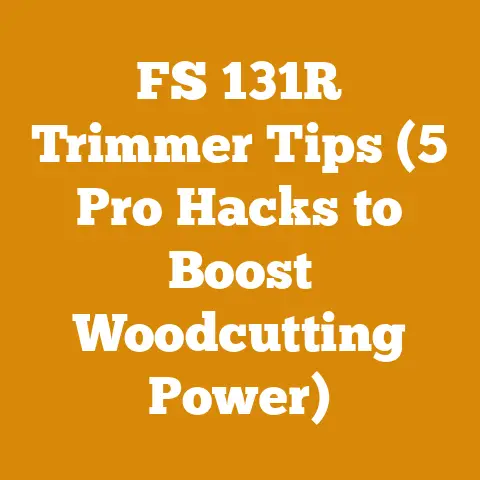Battery Backpack Sprayer Reviews for Wood Processing (Expert Tips)
Battery backpack sprayers are game-changers for wood processing, offering unparalleled precision and efficiency in treating lumber, preventing infestations, and ensuring the longevity of your wood projects.
Understanding the Need for Sprayers in Wood Processing
Wood, a beautiful and versatile material, is unfortunately susceptible to various threats – fungi, insects, and moisture. These elements can degrade wood, compromising its structural integrity and aesthetic appeal. That’s where sprayers come in.
Why Treat Wood?
- Protection from Decay: Fungi thrive in moist environments, causing rot and decay. Wood preservatives applied with sprayers create a barrier against these organisms.
- Insect Infestation Control: Termites, carpenter ants, and other wood-boring insects can wreak havoc on lumber. Insecticides delivered via sprayers effectively eliminate and prevent infestations.
- Moisture Management: Water is wood’s enemy. Sealants and water repellents applied with sprayers help control moisture absorption, preventing warping, cracking, and swelling.
- Finishing and Staining: Sprayers ensure even application of stains, sealers, and finishes, enhancing the wood’s natural beauty and providing a protective layer.
The Evolution of Wood Treatment: From Manual to Battery-Powered
I remember the days of manually pumping sprayers for hours, struggling to maintain consistent pressure and coverage. It was exhausting and inefficient. Battery-powered backpack sprayers changed everything. They offer:
- Consistent Pressure: Eliminating the need for manual pumping, ensuring uniform application of treatments.
- Greater Coverage: Allowing you to cover larger areas quickly and efficiently.
- Reduced Fatigue: Making wood treatment less physically demanding, especially during large projects.
- Precision: Providing better control over spray patterns, minimizing waste and maximizing effectiveness.
Battery Backpack Sprayers: An In-Depth Look
Battery backpack sprayers consist of a tank, a battery-powered pump, a wand with various nozzles, and a comfortable backpack harness. They are designed for ease of use and portability, making them ideal for treating lumber in various settings.
Key Components and Features
- Tank Capacity: Ranging from 2 to 5 gallons, influencing the amount of treatment you can apply before refilling. I find that a 4-gallon tank strikes a good balance between capacity and weight.
- Battery Life: Crucial for extended use. Look for models with lithium-ion batteries offering several hours of runtime. I prefer models with at least 2 hours of continuous spraying.
- Pressure Settings: Adjustable pressure settings allow you to customize the spray pattern and flow rate based on the treatment being applied. Variable pressure (e.g., 20-60 PSI) is a great feature.
- Nozzles: Different nozzles produce different spray patterns (e.g., cone, fan, stream) for various applications. Having a selection of nozzles is essential for versatility.
- Wand Length: A longer wand provides better reach, especially when treating stacked lumber or hard-to-reach areas. I recommend a wand length of at least 18 inches.
- Filtration: A filter prevents debris from clogging the nozzle, ensuring consistent spray performance. Regular cleaning of the filter is essential.
- Weight and Comfort: A comfortable backpack harness with padded straps is crucial for extended use. Consider the weight of the sprayer when full.
Types of Battery Backpack Sprayers
- Diaphragm Pump Sprayers: Ideal for handling abrasive or viscous liquids like stains and sealers. These pumps are durable and require minimal maintenance.
- Piston Pump Sprayers: Suitable for general-purpose spraying of insecticides, fungicides, and wood preservatives. They offer high pressure and consistent flow.
- 18V vs. 20V vs. Other Voltages: Higher voltage usually translates to more power and longer run times. I’ve found 18V to be sufficient for most tasks, but 20V models offer a noticeable performance boost.
Factors to Consider When Choosing a Sprayer
- Project Size: For small projects, a smaller, lighter sprayer may suffice. Larger projects require a sprayer with a larger tank and longer battery life.
- Type of Treatment: Different treatments require different pump types and nozzle configurations. Consult the treatment manufacturer’s recommendations.
- Budget: Battery backpack sprayers range in price from around \$100 to \$400 or more. Consider your budget and the features you need.
- User Reviews: Read reviews from other users to get an idea of the sprayer’s performance and reliability.
Preparing for Wood Treatment: Safety First
Before you start spraying, safety is paramount. Wood treatment chemicals can be hazardous, so take the necessary precautions.
Essential Safety Gear
- Respirator: Protects your lungs from inhaling harmful vapors. I always use a NIOSH-approved respirator with organic vapor cartridges.
- Gloves: Protect your skin from contact with chemicals. I prefer nitrile gloves, which are chemical-resistant and durable.
- Eye Protection: Safety glasses or goggles prevent chemicals from splashing into your eyes.
- Protective Clothing: Wear long sleeves, long pants, and closed-toe shoes to protect your skin. I often wear a disposable Tyvek suit for added protection.
Preparing the Work Area
- Ventilation: Work in a well-ventilated area to minimize exposure to vapors. Open windows and doors or use a fan.
- Cover Surfaces: Protect surrounding surfaces from overspray with drop cloths or plastic sheeting.
- Clear the Area: Remove any objects that could be damaged by the treatment.
- Read the Label: Always read and follow the treatment manufacturer’s instructions carefully.
Mixing and Diluting Treatments
- Accurate Measurement: Use measuring cups and spoons to ensure accurate mixing ratios.
- Proper Dilution: Dilute the treatment according to the manufacturer’s instructions. Over-dilution can reduce effectiveness, while under-dilution can be harmful.
- Mixing Order: Follow the recommended mixing order to ensure proper dissolution and prevent clumping.
- Water Quality: Use clean, potable water for mixing treatments. Hard water can affect the effectiveness of some treatments.
Wood Treatment Techniques: A Step-by-Step Guide
Now that you’re prepared, let’s dive into the actual wood treatment process.
Surface Preparation
- Cleaning: Remove dirt, dust, and debris from the wood surface with a brush or vacuum.
- Sanding: Sand the wood surface to open the pores and improve penetration of the treatment. I typically use 80-grit sandpaper for rough lumber and 120-grit for smoother surfaces.
- Drying: Ensure the wood is dry before applying the treatment. Moisture content should be below 20% for optimal penetration.
Spraying Techniques
- Nozzle Selection: Choose the appropriate nozzle for the treatment and the desired spray pattern. Fan nozzles are ideal for covering large surfaces, while cone nozzles are better for spot treatments.
- Spraying Distance: Maintain a consistent spraying distance of 6-12 inches from the wood surface.
- Overlapping: Overlap each spray pass by 50% to ensure even coverage.
- Spray Pattern: Use a smooth, even spraying motion, moving the wand back and forth or up and down.
- Application Rate: Apply the treatment at the recommended rate, typically measured in ounces per square foot. Refer to the treatment manufacturer’s instructions.
Treating Different Types of Wood
- Softwoods (Pine, Fir, Cedar): Softwoods are more absorbent than hardwoods, so they may require less treatment. I typically apply one coat of preservative to softwoods.
- Hardwoods (Oak, Maple, Walnut): Hardwoods are denser and less absorbent, so they may require multiple coats of treatment. I often apply two coats to hardwoods, allowing each coat to dry before applying the next.
- Pressure-Treated Wood: Pressure-treated wood is already protected against decay and insects, but it may still benefit from a water repellent to prevent warping and cracking.
Specific Treatment Applications
- Wood Preservatives: Apply wood preservatives to protect against decay and insect infestation. I use copper naphthenate-based preservatives for ground contact applications and borate-based preservatives for interior applications.
- Insecticides: Apply insecticides to eliminate and prevent wood-boring insects. I use permethrin-based insecticides for general insect control and borate-based insecticides for termites.
- Water Repellents: Apply water repellents to prevent moisture absorption and reduce warping and cracking. I use silicone-based water repellents for their durability and effectiveness.
- Stains and Sealers: Apply stains and sealers to enhance the wood’s natural beauty and provide a protective layer. I use oil-based stains for their rich color and durability and polyurethane sealers for their water resistance.
Advanced Techniques and Tips
Beyond the basics, here are some advanced techniques and tips I’ve learned over the years to maximize the effectiveness of battery backpack sprayers in wood processing.
End-Grain Treatment
End grain is particularly vulnerable to moisture absorption and decay. Apply extra treatment to the end grain of lumber to seal it and prevent water from entering. I often use a brush to apply a thick coat of preservative to end grain.
Injection Treatment
For existing structures with localized decay or insect infestation, consider using an injection treatment. Drill small holes into the affected area and inject the treatment directly into the wood. This delivers the treatment directly to the source of the problem.
Heat Treatment
Combining heat treatment with chemical treatment can significantly enhance the wood’s resistance to decay and insects. Heat the wood to a temperature of 140-160°F (60-70°C) before applying the treatment. This helps to open the wood pores and improve penetration of the treatment.
Borate Treatment for Firewood
While not a common practice, borate treatments can also be used on firewood to inhibit fungal growth during storage, especially if the wood is not fully seasoned. This can help prevent the firewood from becoming moldy or decaying before it’s burned. However, it’s crucial to use a borate solution specifically formulated for this purpose and to allow the firewood to dry thoroughly before burning.
Treating Wood in Confined Spaces
When treating wood in confined spaces, such as crawl spaces or attics, take extra precautions to ensure adequate ventilation and minimize exposure to vapors. Use a respirator with organic vapor cartridges and wear protective clothing. Consider using a low-pressure sprayer to minimize overspray.
Dealing with Difficult Wood Species
Some wood species, such as redwood and cedar, contain natural oils that can interfere with the penetration of treatments. Before applying the treatment, clean the wood surface with a solvent to remove the oils.
Optimizing Treatment Absorption
To optimize treatment absorption, consider applying the treatment in the early morning or late evening when the temperature is cooler and the humidity is higher. This helps to slow down the evaporation of the treatment and allows it to penetrate deeper into the wood.
Enhancing Stain Penetration with Additives
For hardwoods that are resistant to staining, I sometimes add a small amount of penetrating oil to the stain. This helps the stain to penetrate deeper into the wood pores and create a richer, more even color.
Maintenance and Storage of Battery Backpack Sprayers
Proper maintenance and storage are essential for prolonging the life of your battery backpack sprayer and ensuring its optimal performance.
Cleaning the Sprayer
- Rinse Thoroughly: After each use, rinse the sprayer thoroughly with clean water to remove any residual treatment.
- Clean the Nozzle: Disassemble the nozzle and clean it with a small brush or needle to remove any clogs.
- Flush the Pump: Flush the pump with clean water to remove any residual treatment.
- Clean the Filter: Clean the filter regularly to prevent debris from clogging the nozzle.
Storing the Sprayer
- Empty the Tank: Empty the tank completely before storing the sprayer.
- Store in a Cool, Dry Place: Store the sprayer in a cool, dry place away from direct sunlight and extreme temperatures.
- Protect from Freezing: Protect the sprayer from freezing temperatures to prevent damage to the pump and tank.
- Store the Battery Separately: Store the battery separately from the sprayer to prevent corrosion.
Battery Care and Maintenance
- Charge the Battery Regularly: Charge the battery regularly to maintain its optimal performance.
- Avoid Overcharging: Avoid overcharging the battery, as this can damage it.
- Store the Battery Properly: Store the battery in a cool, dry place away from direct sunlight and extreme temperatures.
- Replace the Battery When Necessary: Replace the battery when it no longer holds a charge.
Troubleshooting Common Problems
- Clogged Nozzle: Clean the nozzle with a small brush or needle.
- Low Pressure: Check the battery charge and the pump filter.
- Leaking Tank: Inspect the tank for cracks or leaks.
- Pump Failure: Replace the pump if necessary.
Real-World Examples and Case Studies
To illustrate the effectiveness of battery backpack sprayers in wood processing, here are a few real-world examples and case studies from my own experience.
Case Study 1: Preventing Decay in a Log Cabin
I was hired to treat a log cabin that was showing signs of decay in the lower logs. I used a battery backpack sprayer to apply a borate-based wood preservative to the affected areas. I also injected the preservative into the end grain of the logs. After several months, the decay had stopped progressing, and the logs were in much better condition.
Case Study 2: Controlling Termites in a Wood Deck
A homeowner was experiencing a termite infestation in their wood deck. I used a battery backpack sprayer to apply a permethrin-based insecticide to the deck joists and support posts. I also treated the soil around the deck with a termiticide. The termites were eliminated, and the deck was protected from future infestations.
Case Study 3: Restoring a Weathered Wood Fence
I restored a weathered wood fence by cleaning it, sanding it, and then applying a water repellent using a battery backpack sprayer. The fence looked like new again, and it was protected from future water damage.
Personal Experience: Building a Rot-Resistant Shed
When building a shed in my backyard, I made sure to treat all the lumber with a combination of wood preservative and water repellent using my battery backpack sprayer. Even after several years of exposure to the elements, the shed is still in excellent condition, showing no signs of decay or water damage. The initial investment in treatment and the sprayer has paid off handsomely in terms of longevity and reduced maintenance.
The Importance of Proper Drying: A Lumber Mill’s Lesson
I once consulted with a small lumber mill that was experiencing significant losses due to fungal staining and decay in their freshly sawn lumber. They were relying solely on air drying, which was proving insufficient in their humid climate. I recommended that they invest in a kiln drying system and implement a strict schedule of applying anti-stain chemicals with battery-powered backpack sprayers immediately after sawing. This combination drastically reduced their losses and improved the quality of their lumber.
The Future of Wood Treatment
The future of wood treatment is likely to involve more environmentally friendly treatments and more sophisticated application methods.
Emerging Technologies
- Bio-Based Treatments: Researchers are developing wood treatments based on natural materials, such as plant extracts and fungi.
- Nanotechnology: Nanoparticles can be used to deliver treatments deep into the wood, providing long-lasting protection.
- Smart Sprayers: Smart sprayers use sensors and GPS to optimize treatment application and minimize waste.
Sustainability and Environmental Considerations
- Use Environmentally Friendly Treatments: Choose wood treatments that are low in VOCs and other harmful chemicals.
- Minimize Waste: Apply treatments carefully to minimize waste and prevent contamination of the environment.
- Dispose of Waste Properly: Dispose of empty treatment containers and leftover treatments properly according to local regulations.
Innovations in Sprayer Technology
- Improved Battery Technology: Longer-lasting and more powerful batteries will allow for extended use and greater spraying capacity.
- Smart Nozzles: Smart nozzles will automatically adjust the spray pattern and flow rate based on the treatment being applied.
- Ergonomic Design: Improved ergonomic design will make battery backpack sprayers more comfortable to use for extended periods.
Conclusion
Battery backpack sprayers are indispensable tools for wood processing, offering unparalleled precision, efficiency, and convenience. By understanding the principles of wood treatment, choosing the right sprayer, and following proper safety procedures, you can protect your wood projects from decay, insects, and moisture, ensuring their longevity and beauty for years to come. Embrace this technology, and you’ll find that wood processing becomes less of a chore and more of a rewarding craft.
Remember, the key to success lies in preparation, proper technique, and consistent maintenance. Don’t cut corners, and always prioritize safety. With the right knowledge and tools, you can achieve professional-quality results and enjoy the satisfaction of working with well-protected, durable wood. Now, go forth and protect your wood!






